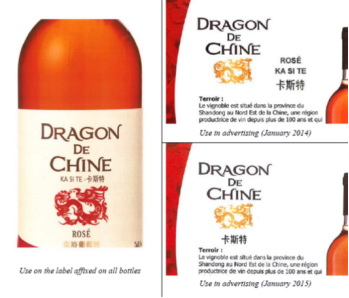Chinese character trademarks enjoy lowered distinctiveness in EU
The recent judgement of the General Court of the European Union in Case T‑323/21 Castel Frères v. Shanghai Panati Co. deals with the genuine use of a trade mark and distinctiveness of Chinese character trade marks in the EU. The Court decided that the registration of the contested Chinese character trade mark shall be revoked because its level of distinctiveness is below the average and it had been only used as a decorative element and not as an indication of origin of the goods.
Background
On 29 May 2018, Shanghai Panati Co. filed an application with the EUIPO for revocation of the EU trade mark that had been registered based on an application filed on 17 March 2008 by Castel Frères. The trade mark in question consists of the following three Chinese characters:

The trade mark holder had used the mark as follows:

Shanghai Panati Co. based its argumentation on an Article 58 of EUTM Regulation 2017/1001, which states that "The rights of the proprietor of the EU trade mark shall be declared to be revoked … if, within a continuous period of five years, the trade mark has not been put to genuine use in the Union in connection with the goods." According to Shanghai Panati Co., the trade mark had not been in genuine and constant use for the past five years. Therefore, through the passive action of the trade mark holder, the trade mark should be annulled.
The Cancellation Division of the EUIPO rejected the application for revocation on 3 April 2020 and Shanghai Panati Co. ended up filing a notice of appeal. The Board of Appeal of the EUIPO approved the appeal and revoked the contested mark. This was based on the fact that "The Board of Appeal found, in essence, that the differences between the contested mark and the mark as used were such as to alter the distinctive character of the contested mark." Castel Frères decided to file an appeal to the General Court.
The Decision
The General Court upheld the decision. The reasoning of the decision can be summarised as follows:
The trade mark "…is a figurative mark consisting of three characters from the Chinese alphabet”. The Court further notes that “the relevant public will not be able to verbalise or to memorise those Chinese characters, which will rather be perceived as meaningless, abstract signs or as decorative elements referring to China or to Asia. It is appropriate, therefore, to find that, with regard to the goods at issue, the Chinese characters forming the contested mark have a lower-than-average degree of distinctive character."
The trade mark, which was used "…in an ancillary position and in a much smaller size than the distinctive and dominant word elements "dragon de chine" and the representation of a dragon, would be perceived by the relevant public as a decorative element and not as an indication of origin of the goods."
Conclusion
There are two important take-aways from this decision. First, the Chinese character trade marks enjoy lower level distinctiveness in the European Union as they are not perceived as having any meaning among European consumers. They are merely abstract signs even when used as a trade mark. The same interpretation can presumably be applied to trade marks consisting of non-European alphabets. Second, in order to fulfil the requirement of genuine use of a trade mark in the European Union, a trade mark should not be used only as a decorative element alongside other trade marks in the product, packaging or advertising. This is often the case with slogans.
-
Previous:
-
Next:






